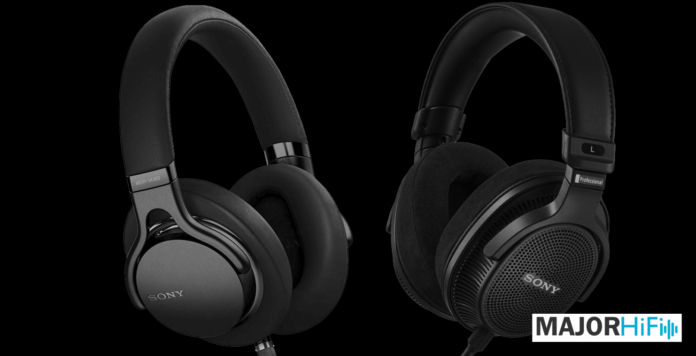For many years, Sony’s professional line of headphones has been a favorite for sound mixers everywhere. The recent release of the MDR-MV1 has made waves as its first open-back effort for studios, but how does it compare to its similarly priced closed-back counterpart, the MDR-1AM2? This comparison will help make sense of which version might fit your mixing needs the best, and the general pros and cons of each.
What You Get
| MDR-MV1 | MDR-1AM2 |
|
|
Look & Feel
These are two completely different builds from the ground up. The MV1 doesn’t look like they just put some vents on the 1AM2. It has its distinct style, and it works for what it is. Both headphones are meant to be worn for long studio sessions, and their comfort level reflects that. I really can’t see any negative here, as both headphones have a snug and don’t cause any obstruction or fatigue.
Design
Both headphones have 40mm dynamic drivers. Their interior designs are quite simple, and although they carry different impedances, they’re both low enough to be driven from any source. If you have an audio interface, then you should be good to go. The MV1 does advertise spatial audio mixing capabilities, but that depends on your DAW and general studio setup. Open-back headphones are better for spatial audio mixing, but you can use closed-back headphones too.
Soundstage
Comparisons between open-back and closed-back headphones will more than likely favor the open-back when discussing the soundstage. That isn’t to say that the 1AM2 doesn’t get the job done. Of course, the MV1 will provide you with more space between sound elements, spreading out the stereo image to make everything easier to discern. The 1AM2 doesn’t lack accuracy though, as its precision matches the MV1 well. However, when testing these headphones back and forth, it’s easy to notice the limit the 1AM2 has. You’re more engulfed in the mix, but the MX1 makes localization easier. This is much preferable for mixing, as it makes it easier to critically analyze specific performances and put a magnifying glass up to them. If you’re just monitoring though, and not making any moves that will considerably change the sound of your mix, then the 1AM2 should get the job done.
Low End
Sony rarely disappoints when it comes to the bass of its headphones. Both the MV1 and 1AM2 have a decent level of detail and power that aims for an engrossing but natural display of low-end frequency content. The bloom of the 1AM2 is quite larger than the MV1, but the MV1 still supplies some rich frequency content in its lows. Those frequencies arrive a bit slower though compared to the 1AM2. If you don’t like the bass as centered and hard-hitting when making decisions for your mix, then you might prefer the MV1 here. Those who want more of an edge to their bass timbre will probably want the 1AM2.
Mids
For two pairs of reference headphones, the midrange needs to be completely even across a good amount of the frequency spectrum. This is mostly the case for the 1AM2, but the MV1 is a bit more complex. There are spots of accentuation with the MV1, so I wouldn’t call it completely flat. The 1AM2 and MV1 are neck and neck when it comes to natural properties, but the MV1 tends to highlight some sound elements over others. Some of the sounds that aren’t showcased will tend to have more bleed, but it’s not destructive to the overall sense of accuracy being conveyed.
Highs
The 1AM2 and MV1 couldn’t be more different in the high frequencies. If you like your treble smooth, and you don’t like too much attention being called to it, then the 1AM2 will be more for you. With the MV1, a lot more focus is granted to the highs, and it is considerably more lifted than the 1AM2. There’s more frequency content to articulate, and the MV1 responds well, but not without some sharp edges. When compared to other mixing headphones from the likes of Beyerdynamic, these highs will be easier to digest. However, if you’re treble sensitive, then the 1AM2 will be both more comforting in its highs, as well as accurate.
Summary
There isn’t a simple answer as to which one is better than the other. Both the MDR-MV1 and 1AM2 have their distinct uses for professional and casual use. The MV1, open-back principle makes imaging easier to control, but you may prefer some timbral elements that the 1AM2 has to offer, like its flatter mids, and easy-going highs.
The Sony MDR-MV1 and MDR-1AM2 are available from Audio46.
Compare the ranking of various headphones, earbuds and in-ear monitors using our tools.
Discuss this, and much more, over on our forum.
---MAJORHIFI may receive commissions from retail offers.















